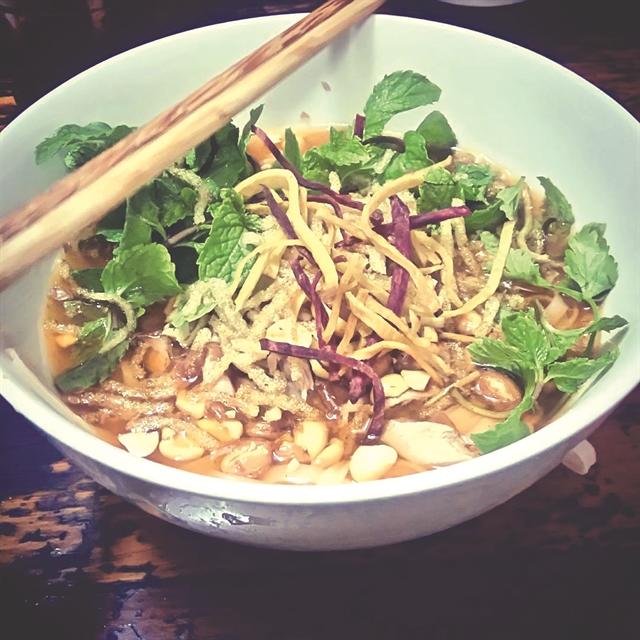 Life & Style
Life & Style


|
| Instead of soup (or broth), cốn sủi is served with sauce, just enough to make the noodle strands shiny and soaked in spices and toppings.—Photo hoahoctro.com |
By Minh Minh
Phở (noodle soup) might be Việt Nam’s most famous dish, but there are plenty of siblings of the world-famous delicacy worth slurping down.
One such dish is cốn sủi, which literally means dry food in sauce, is a must-try delicacy of Sa Pa Town, the northern province of Lào Cai. Local people also call it phở khan (dry noodles) to differentiate it from its more famous relative.
Instead of soup (or broth), the noodles are served with sauce, just enough to make the noodle strands shiny and soaked in spices and toppings.
The dish originated in China, which borders Lao Cai and in one bite of cốn sủi, you can feel the chewy taste of noodle strands, the crunchy peanuts, the sweet char siu porki and the crispness of fried sweet potatoes.
The sauce gathers sour, spicy, hot, salty and sweet flavours brilliantly.
My friend, Nguyễn Hoàng Lan said cốn sủi is her favourite dish for breakfast in Sa Pa. As a tourist, she tried to discover all the delicacies of Sa Pa. Beside salmon, dried buffalo meat, grilled food and colourful sticky rice, Lan loves cốn sủi and recommended that tourists should go to Quán Ông Há, 591 Điện Biên Phủ Street, Sa Pa, to try the dish.
The dish contains char siu pork sliced into threads, a quarter of a boiled egg, fried strands of sweet potatoes and many kinds of herbs and is topped with roasted peanuts.
“It sounds complicated but also sophisticated, only a small piece of boiled egg to create a highlight for the dish and make us desire more. Purple, yellow and orange threads of sweet potatoes paint the bowl colourful.”
Lan stressed that each ingredient can be compared with a musical note to make a wonderful symphony.
“I believe what makes the success of this dish is its gelatinous sauce which has the impressive scent of black cardamom and cinnamon,” she said.
“The sauce is made from the broth of pig bones cooked for hours. Mixing the spices to make the harmony and balance for the sauce is an art of the chef.”
When a customer makes an order, the seller pours the hot sauce into the bowl, completing the cốn sủi, perfect for soothing the stomach and soul in the chill of Sa Pa Town.
“I can’t ask for more, white noodles, green herbs, pink char siu, purple, yellow and orange sweet potatoes, red chili, brown peanuts; together they create a brilliant painting,” said Lan.
Sa Pa is covered by fog at dawn. The sun hides behind mountain peaks and forests and a bowl of hot cốn sủi is the perfect start to a crisp day.
The charming scent and warmth of the dish is enough to make one go into ecstasy, waking up all the senses.
The dish has become a beautiful memory of Sa Pa and someone talks to me about cuốn sủi, the taste of the dish seems still linger on my lips.
Writer Tống Ngọc Hân, a resident in Sa Pa Town, said the dish is popular, delicious and not expensive.
“The taste is very special, it wins people’s hearts even for someone who has never tried it before,” said Hân.
“Cốn sủi is one among significant delicacies of Lào Cai Province, though I love it so much, I have never tried to make it at home because making the sauce is very complicated and requires a special secret recipe,” she said.
“The dish originates from China but the Chinese version is hotter than the one served in Lào Cai. The Vietnamese chefs reduce the amount of chilli to suit local people’s taste.”
The waiter at Quán Ông Há said the restaurant receives many domestic and foreign tourists. The secret recipe is passed down from generation to generation, seven up to now. It’s easy to understand why it’s the most popular restaurant to enjoy cuốn sủi in Sa Pa.
Apart from cốn sủi, gourmands can also order wonton noodle and jiaozi (Chinese dumplings). — VNS



